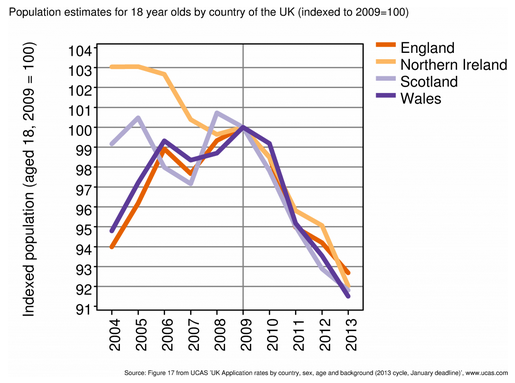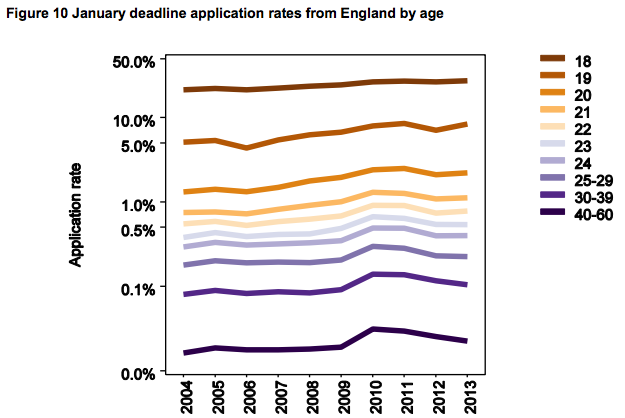In spite of £9k fee hike, student numbers rise again
Contrary to expectations, this year's UCAS applications are the third highest on record.
Though applicant numbers are still markedly down from pre-tuition fee hike levels, final UCAS figures show there's been an unexpected 3.5% rise in applications for 2013/14.
This is at odds with December's first-count figures which had revealed that for the second year in a row fewer people were applying to university in England and Wales. The numbers had dropped by 54,000 students (6%) since December 2011, when there had already been a year-on-year fall of 6.4%.
In its 2012 end-of-cycle report, UCAS had announced that "2012 has been one of the most complex and challenging years for entry to higher education that the sector has ever known." The table below seemingly shows the appearance of a downward trend, but today's results appear to have contradicted that.
Join 72,953 people who trust us to check the facts
Sign up to get weekly updates on politics, immigration, health and more.
Subscribe to weekly email newsletters from Full Fact for updates on politics, immigration, health and more. Our fact checks are free to read but not to produce, so you will also get occasional emails about fundraising and other ways you can help. You can unsubscribe at any time. For more information about how we use your data see our Privacy Policy.
Writing for the Financial Times in December, Chris Cook observed how "half of the 54,000 decline was driven by a drop in deferrals: few students who could enter university in 2011-12 elected to wait until 2012-13, when the higher fees kicked in."
January 15 was the final deadline for university applications (hence the reason for UCAS's second count in January). In June universities will be accepting more applications via the clearing process, and by the end of the year we'll have an idea of where the trend is headed.
So far, it looks like application rates for 18 year olds for each UK country are at the highest levels recorded. Application rates from disadvantaged 18 year olds are also at record levels.
Steven Tall makes a crucial point and provides some interesting insights about this phenomenon in his blog. One could explain the record application rates from eighteen year olds with a corresponding decline in absolute numbers of the population size of 18-19 year olds.
The point is illustrated by a UCAS graph.

The Prime Minister welcomed the findings at the House of Commons yesterday: "After all the concerns expressed about how the new way of paying for university finance would reduce the number of students applying to university, the number of 18-year-olds has actually risen and is now level with where it was in 2011, which is higher than in any year under the last Labour Government."
But this doesn't mean application numbers have risen for everyone. New university funding arrangements are still having an impact, and as the graph below shows, applications from mature students aged 30 plus are declining.

What's also interesting is that what subject areas are proving popular: mainly Computer Science (up by 12.3%), Engineering (+8.4%), Veterinary Science (+7.7%), and Bio Sciences (+6.9%).
The increase in applications is in line with longer term upward trends in both the number of university applicants and the number of students over the past 40 years.
UCAS holds data on end-of-year applicant numbers from 1962 to 2012 (before the £9k fee cap was introduced):
On the other side of the spectrum, there were 51,000 (-13%) fewer acceptances into English institutions for this 2012-13 academic year than in the previous year, and similar proportional falls at Welsh universities.
Though the acceptance rate increased from 2011-12, as we can see from the graph below (source: UCAS) there was a noticeable fall in the number of net acceptances which is contrary to the trend for the past five years.
A sustained fall in university application numbers was the single biggest danger to Coalition higher education strategy. The news that the rate of student applications has increased will therefore be welcome by the Government, and might lend credibility to their tuition fees policy.
---
Flickr image courtesy of LiverpoolHopeUniversity